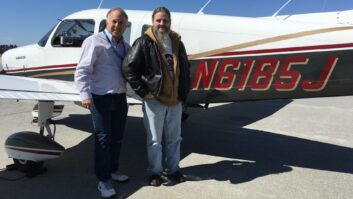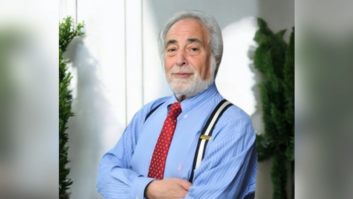QUINCY, Ill. Friends say Hilmer Swanson came up with some of his best broadcast innovations while riding a tractor in a field tending to his gentleman’s farm near here. However, it was what he did with those ideas in the lab that made him a world-renowned AM transmitter designer in the eyes of colleagues.
Swanson, 72, passed away at a nursing home near Quincy in July, after a short illness.
Peers at Harris credit Swanson with inventing nearly every modulation technique used in modern AM broadcast transmitters, including Pulse Duration Modulation, Progressive Series Modulation and Digital Amplitude Modulation.
“It wasn’t just Hilmer’s technical skills that made him great, but his ability to work outside the box. He had the talent that many creative people have to do things others couldn’t,” said Geoff Mendenhall, vice president of research and development at the Harris Broadcast Communications Division.
Swanson began his broadcasting career at Collins Radio in the early 1960s, then joined Parker Gates in the Gates Radio Division (which would become the Harris Broadcast Division) at Harris-Intertype Corp. in 1965.
The senior staff scientist retired after 35 years at Gates/Harris in 1999 but maintained an office at Harris and worked part-time on occasional projects.
Swanson Street
In fact, Harris had named one of its company streets at its Quincy complex after Swanson.
“Parker Gates and I recruited Hilmer to come to Quincy after Collins Radio announced it was moving its facility from Cedar Rapids (Iowa) to Dallas. Hilmer was a Midwesterner and didn’t want to move,” recalled Larry Cervon, former vice president and general manager at Gates/Harris.
Cervon said he allocated Swanson $25,000 to begin the PDM program at Gates to develop an efficient, high-power MW transmitter.
“The very first PDM transmitter we sold was a 100,000 kW MW for Voice of America, which was sent to Thailand. Hilmer’s design eliminated the modulation transformer and cut the cost of operation dramatically. The efficiencies were so good,” Cervon said. “I believe Hilmer considered his PDM work his greatest achievement.”
During more than three decades at Gates/Harris, Swanson received many awards, including the NAB’s Engineering Achievement Award in 1990 and the Harris Fellow Award.
“Hilmer had a quiet manner and was a man of few words, but when he did speak he had everyone’s undivided attention. He was very introspective,” said Mendehall, who considered Swanson his mentor.
In fact, Swanson was the behind-the-scenes mentor to many talented young engineers and technicians, friends say.
“He was always very approachable … a willing teacher,” said Tim Bealor, vice president of RF systems at Broadcast Electronics. “Even as recent as the NAB in Las Vegas (this past April) he was there and very visible. He was always curious about the industry and what was new.”
Swanson’s farm was just down the road from Broadcast Electronics’ facility, also in Quincy. Bealor said BE, as a company, easily recognized Swanson’s contributions to the broadcast industry.
“He was a radio guy. His interest was in radio and his goal was to find new ways to make AM transmission better and he accomplished that,” Bealor said.
Design breakthrough
It was Swanson’s work on tube-type AM systems for shortwave and medium-wave markets in the 1960s that caught the attention of Tom Yingst, former vice president and general manager of Harris Broadcast Division from 1988 through 1991.
“Little did I know that I would eventually join Harris in 1988 and have the privilege of working with one of the world’s outstanding AM engineers,” he said.
Yingst cited Swanson’s work on solid-state MW transmitters as a major breakthrough “that led to the DX solid-state, digital amplitude modulation AM transmitter.
“The success of the DX transmitter design was directly related to Hilmer’s concepts and allowed Harris to become a leader in the world AM transmitter market at power levels from 10 kilowatts through 2,000 kilowatts,” Yingst said.
Swanson authored numerous articles and technical reports and frequently delivered them at industry conferences. One of his last works was a paper, “Performance of Modern AM Modulation Methods for Linear Digital Broadcast Applications,” co-authored by John Delay.
During his career, Swanson was awarded 27 U.S. patents and several international patents. Friends say his innovations not only significantly improved the sound of AM transmissions, but also dramatically lowered electric bills because of increased transmitter energy efficiency.
Harris estimated his innovations have slashed the world’s AM transmitter power bill by at least $100 million over the past 20 years.
Missionary work
Friends say Swanson donated many hours as a technical consultant to the design and construction of shortwave AM transmitters used by the HCJB religious ministry broadcasting from Quito, Ecuador.
After retiring from Harris in 1999, Swanson performed missionary work in places such as Palau, Chile and Estonia, putting Christian AM radio stations on the air.
After serving in the Army during the Korean War, Swanson was employed for a short time at Bendix in Davenport, where he worked on his first invention, the Ultrasonic Jewelry Cleaner. He then attended Iowa State University at Ames and received his Bachelor of Science degree in engineering from Valparaiso Technical Institute.
He went on to graduate school at the University of Iowa in Iowa City, where he worked as a student teacher while pursuing a Master of Science degree in electrical engineering, which he received in 1961.
Swanson was a life member of Sigma Xi, Science Honor Fraternity; an honorary member of the SBE; and a life member of IEEE.
His wife Carolyn, four children and five grandchildren survive him.







